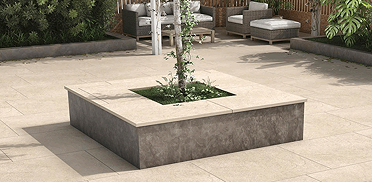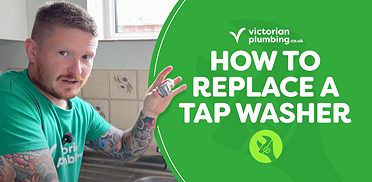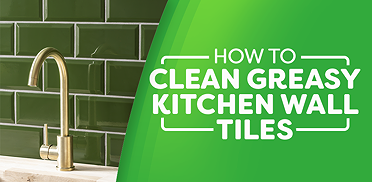UP TO 60% OFF BIG BATHROOM SALE ENDS SOON!
*Free delivery on orders over £499
How to Unblock a Shower Drain
How to Unblock a Shower Drain
Trying to figure out how to unblock a shower drain fast? This no nonsense guide gives you nine proven ways to clear a blocked shower drain and remove clogs.
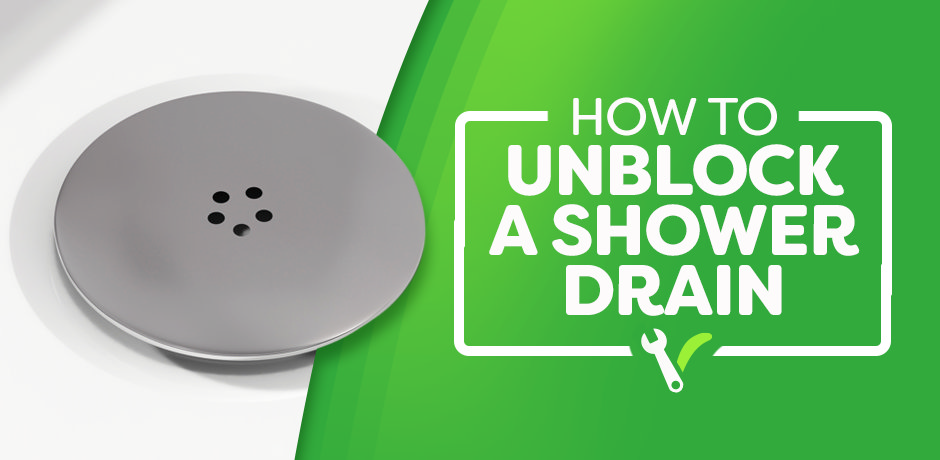
There’s a moment in every shower when you realise the water level isn’t sliding away; instead, it’s rising around your ankles in a lukewarm puddle. A blocked shower drain seems to appear overnight, but the build-up is usually slow, silent and, fortunately, easy to reverse once you know what’s causing it, how to clear it and how to stop it happening again. This guide walks you through every stage, from recognising the first signs of trouble to the gentlest DIY fixes and, if needed, the point at which a professional becomes the sensible next step.
Click Through Contents
- 9 Proven Methods to Unblock a Shower Drain
- Why Shower Drains Block
- Early Warning Signs Of A Clogged Drain
- Tools, Materials and Preparation
- Safety Rules For Clearing A Clog
- Prevention That Really Works
- FAQs and Common Myths
- Wrap Up and Next Steps
9 Proven Methods to Unblock a Shower Drain
1. Very Hot or Boiling Water
Heat a full kettle, wait a minute for plastic pipes or skip the wait for metal, then pour the water in two or three slow batches thirty seconds apart. The thermal shock melts soap fats and softens grease. Run the hot tap for a minute afterwards and repeat once if the flow improves but still seems hesitant.
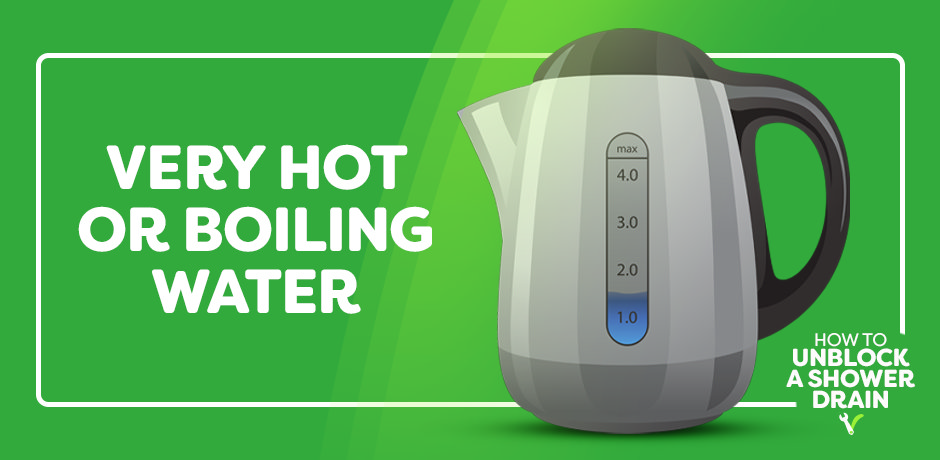
2. Baking Soda and Vinegar (With Salt Variant)
If water stands in the tray, bail it away, then tip half to one cup of baking soda into the opening. Follow with an equal measure of white vinegar and cap the drain with its plug or a rag. The mixture fizzes, expanding through crevices and lifting grime. Let it work for at least fifteen minutes, an hour for stubborn mats, then chase it with a kettle of hot water. A second round is acceptable if the flow is merely sluggish. For extra grit mix half a cup of table salt with the soda before the vinegar. Take care not to over-pour; too much reactant can foam up into the shower enclosure.
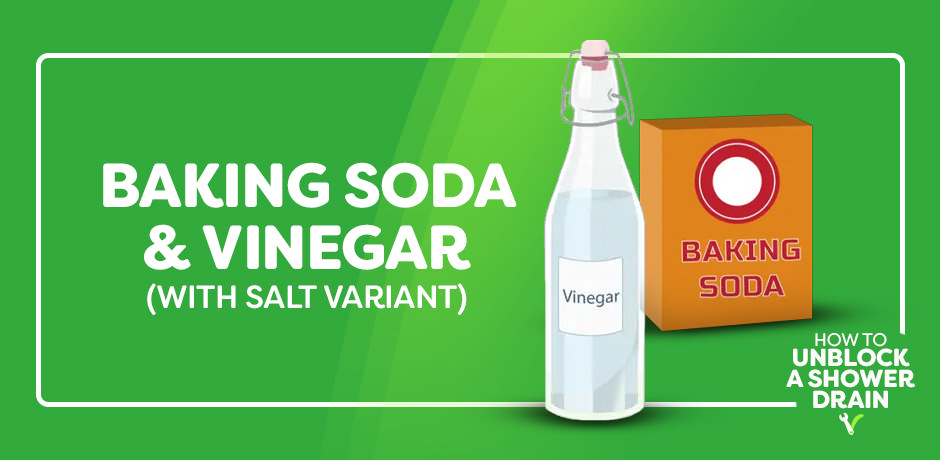
3. Lemon Juice or Enzyme Cleaner
One cup of real lemon juice left to sit ten to sixty minutes dissolves light scale and deodorises. Flush with hot water and admire the fresh scent. For maintenance rather than crisis, choose a live-enzyme cleaner, dose as the label directs and leave it overnight so friendly bacteria can digest residue. Hot water in the morning completes the job.
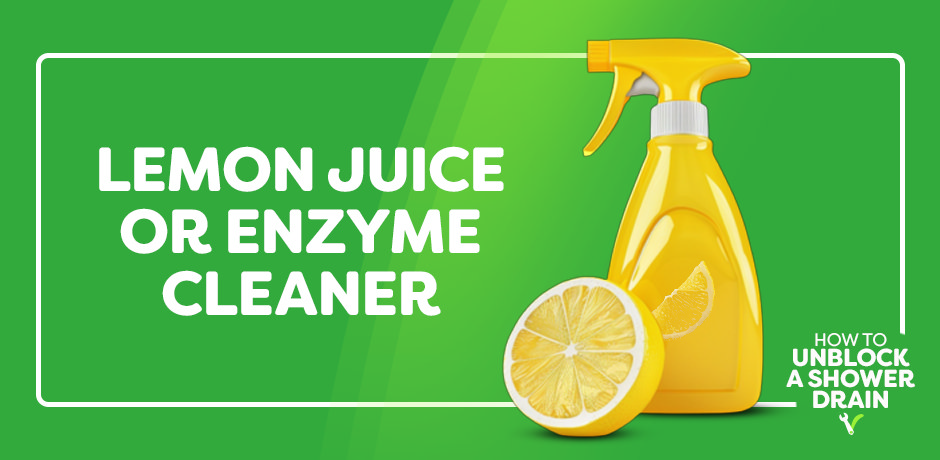
4. Dish Detergent Lubricant
Scoop standing water aside, squeeze a quarter cup of thick dish soap into the waste and wait five to ten minutes. The detergent coats greasy clumps and frees hair from the pipe wall. Follow with a kettle of hot water poured in one deliberate shot. A second application is safe if the first improves but does not finish the task.
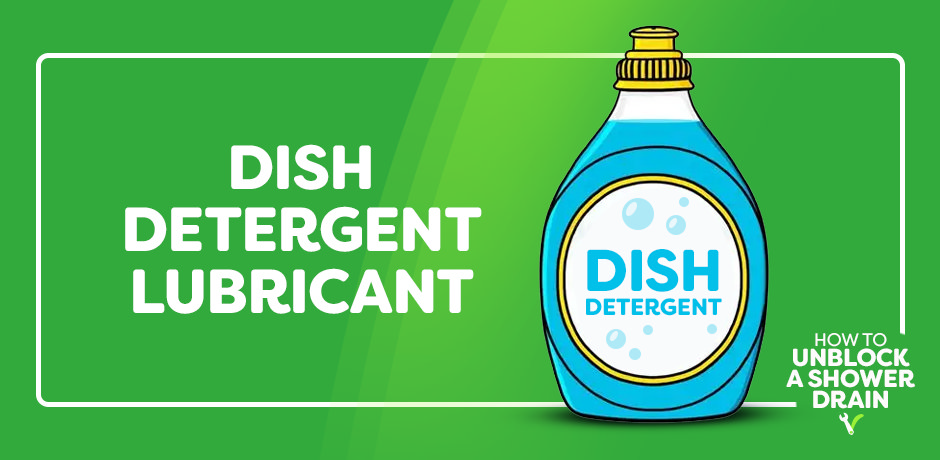
5. Plunger Routine
Push a wet rag hard into the overflow port, then add water until the plunger cup is submerged by an inch or two. Smear petroleum jelly round the rim for an airtight fit. Centre the cup, press slowly to expel air, then pump six to twenty times with brisk strokes. Break the seal and check whether water drains. Two or three cycles, each followed by a test, conquer most near-surface clogs.
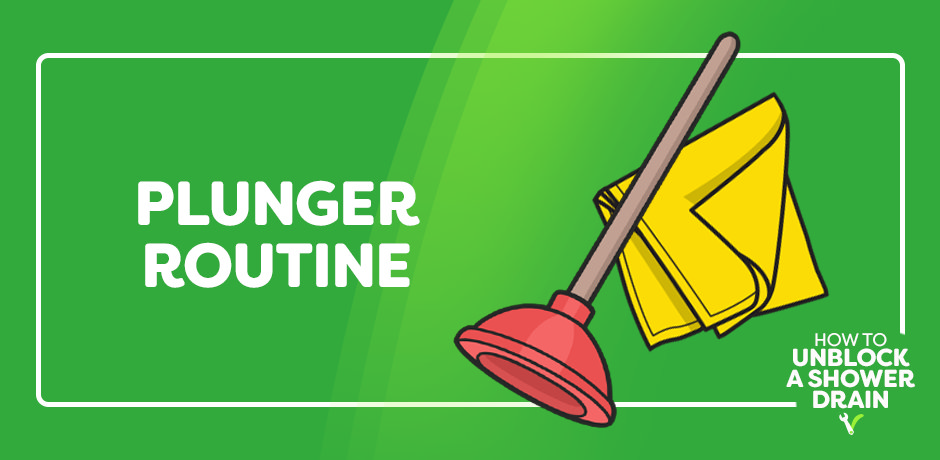
6. Manual Extraction by Hand or Hook
Unscrew or prise up the drain cover and shine a torch inside. Where hair is visible, pull it with gloved fingers, tweezers or pliers. If the mat sits deeper, straighten a wire coat-hanger, create a half inch hook, feed it down, twist to snag the bundle and draw it up. A plastic barbed strip works on the same principle. When a removable P-trap is accessible, place a bucket underneath, unscrew the union nuts, empty the trap, scrub it clean and re-seal the joints with hand tight pressure.
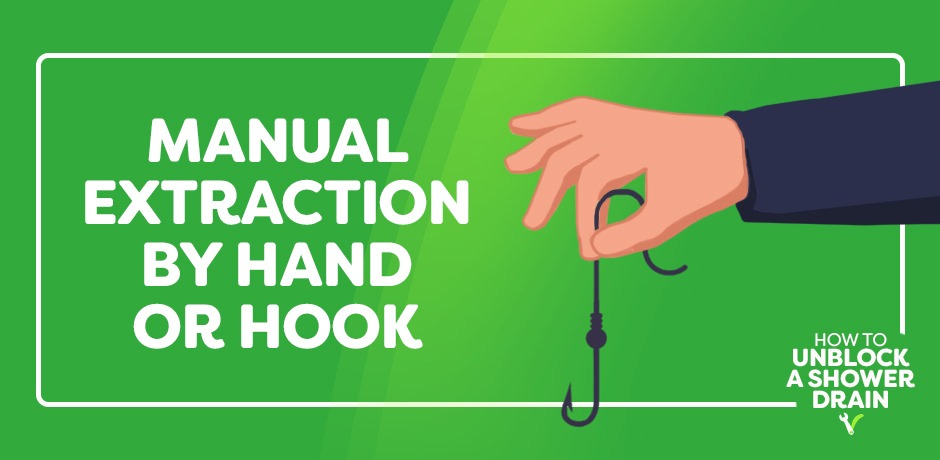
7. Drain Snake or Hand Auger
Remove the stopper or P-trap for a clear run. Loosen the thumbscrew, feed the cable until you feel resistance and rotate the handle while pushing gently until the tip bites through the obstruction. Wind the cable back, wipe debris into the bucket and flush the line with hot water at full blast. If the snake refuses to advance, withdraw, wipe clean and try again at a slightly different angle rather than forcing the coil.
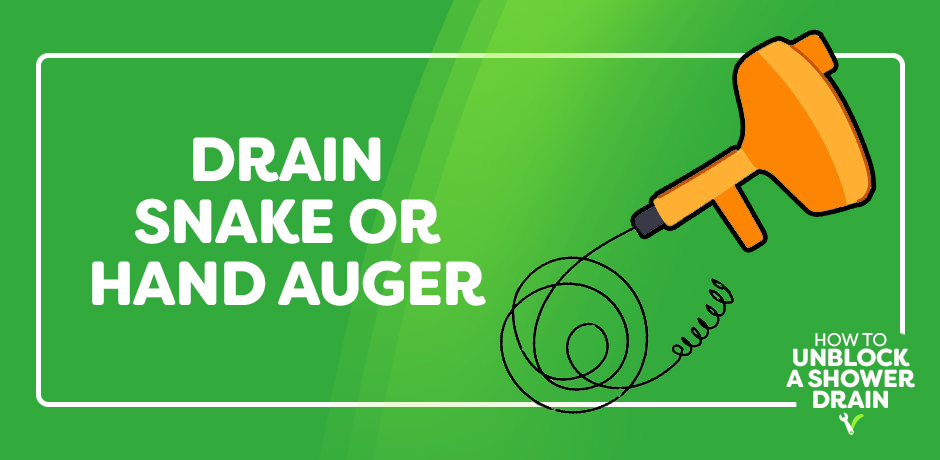
8. Hair Conditioner or Petroleum Jelly Trick
After removing loose hair, squeeze half a cup of silicone rich conditioner, or spoon a slug of petroleum jelly, down the waste. Leave twenty to thirty minutes so the slick coating seeps into the tangle, then flush with very hot water. The lubrication often persuades a stubborn soap-hair mat to slide away.
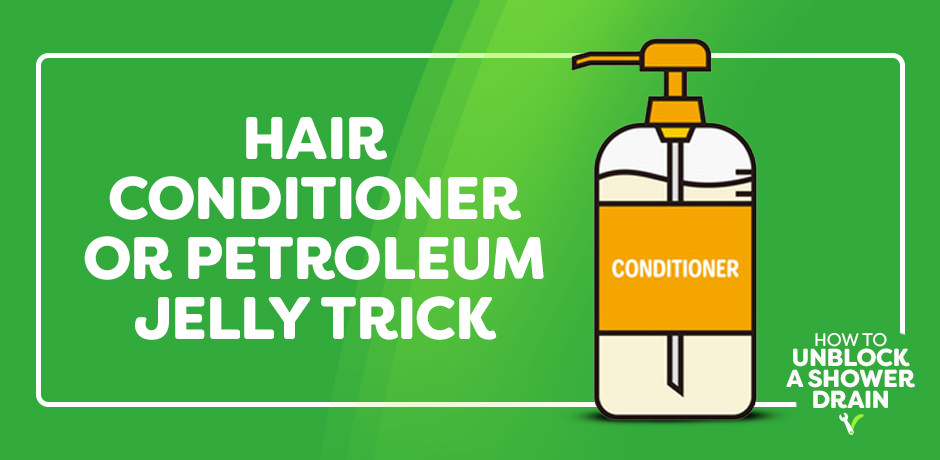
9. Chemical Drain Opener (Absolute Last Resort)
Choose a caustic gel compatible with your pipe material and don full protective gear plus max ventilation. Pour the measured dose slowly, step back and wait precisely as the label instructs. Do not plunge, snake or add vinegar during the wait. Rinse with hot water, then cold. If no improvement follows a single repeat, stop and call a plumber, informing them of the product used so they can protect themselves.
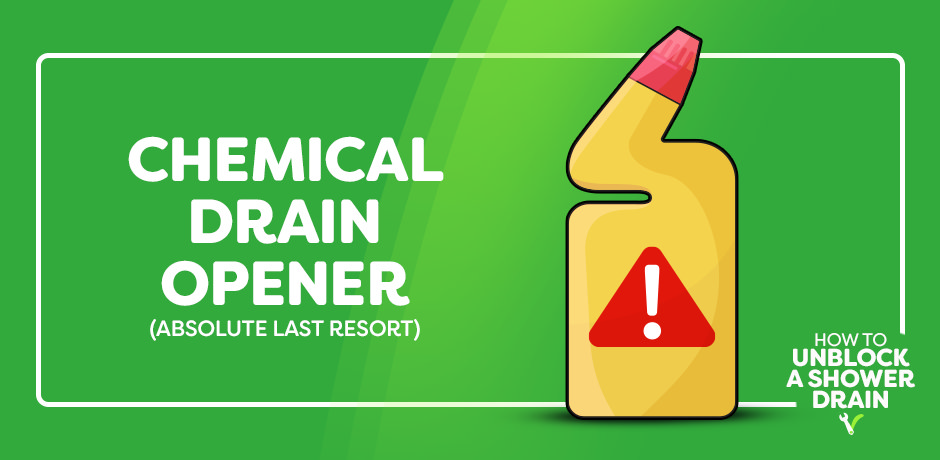
What Causes a Blocked Shower Drain
Day after day, everything that runs off our skin, hair and bathroom shelves travels to the same small opening. Human and pet hair bind together with soap film, beard trimmings and stray cotton strands. Bar soap fats react with hard-water minerals, leaving a chalky scum that glues debris to the pipe walls. Thick conditioners, bath-bomb oils and body scrubs add grease and grit. Every once in a while a razor cap, toy brick or bottle lid slips down the waste and lodges at a bend. Outdoors, tree roots can squeeze through ageing joints and narrow the bore from the outside in. Over time those individual culprits merge into one stubborn, water tight plug.
Early Warning Signs for Shower Drain Blockage
A shower drain rarely blocks without sending up flares. The first clue is almost always slower drainage: the water forms a small whirlpool, then lingers longer after you switch off the flow. Next comes the ankle-deep pool halfway through your wash. Alongside sluggish water you may hear faint gurgles, smell a musty or sulphurous whiff or notice fruit flies hovering over the grate. Ignore these hints and you risk water seeping through the tray sealant or, worse, backing up into nearby fixtures like the basin or toilet.
Tools Needed to Unblock Your Shower Drain
Before you lift the drain cover, lay out what you need. Protect yourself first: slip on rubber gloves, old clothes and safety goggles, and open a window or run the extractor for fresh air. Keep a bucket, an old towel and a flashlight within reach; the bucket catches displaced water, the towel cushions tools and the torch helps you see deep into the waste.
Hand tools do most of the work. A shallow-cup sink plunger pairs with a wet rag that you’ll press into the overflow to seal it. Tweezers, needle-nose pliers or a bent wire coat-hanger can hook hair clumps. A plastic barbed strip – sometimes sold as Zip-It – slips past the trap bend and drags debris back. For tougher blockages a manual drain auger winds a steel cable down the pipe; if that stalls, a motorised version adds bite.
Household staples stand in for chemicals: very hot water loosens soap, bicarbonate of soda followed by white vinegar fizzes through grease, and thick dish detergent lubricates matted hair. Keep baking soda, vinegar, table salt and a kettle handy. Save caustic drain openers for last resort and read the labels twice.
Finally, plan your workspace. Remove shampoo bottles from the tray, spread a sheet beside the shower to rest tools on and have a second rag ready to block splashes when you plunge.
Dealing With Clogged Shower Drains Safely
- Gear up first. Slip on rubber gloves and safety goggles before you even loosen the cover; they stay on until the basin’s running clear.
- Ventilate. If you reach for a caustic gel, add a mask and crank open the window or fan.
- One product at a time. Never stack cleaners. Bleach on last week’s drain gel or vinegar on a branded chemical can spit toxic fumes. Note any product you’ve used so a visiting plumber can protect their skin and eyes.
- Respect the heat. Boiling water is perfect for cast iron or copper stacks. For PVC, acrylic or push-fit waste, let the kettle cool a minute, very hot, not rolling boil, so joints don’t soften.
- Control the pressure. Before plunging, block the overflow with a wet rag so force drives downward. Use the right tool. A flat-cup plunger for floor or sink drains, a flanged plunger only for toilets.
- Go gentle with a drain snake. Feed the cable slowly and turn just enough to bite; cranking hard can crack a trap or gouge an old elbow.
- Start mild. Escalate only when necessary. Hot water, then soda-vinegar, then mechanical tools, reserving chemicals, or a professional, for the truly stubborn drain clog.
Preventing Shower Drain Clogs
Fit a stainless steel drain screen and empty it after every shower; catching the strands at source is half the battle. Give hair a quick brush before you step under the spray so fewer loose fibres reach the grate, and trade fatty bar soap for liquid body wash to reduce the scum that limescale loves to harden. When you finish washing, lift out any visible hair, swish clean water round the tray and you’re done for the day.
Once a week, reward the pipework with a two minute blast of very hot tap water (or a cooled kettle pour) to keep soaps and oils molten enough to move on. Each month, pour a cup of white vinegar down the drain, leave it for half an hour, then flush hot, or use an overnight enzyme dose if you prefer a gentler, scent free option. Keep grease, paint rinses and small toys out of the enclosure entirely. If you live in a hard water area, add a scale inhibitor cartridge or a full softener to stop minerals binding with soap. Book a CCTV inspection every year or two to spot early root ingress or ageing joints, and occasionally fill the tray for a second before opening the waste; that surge helps sweep lingering grit through the system.
FAQs and Common Myths
How long will it take to unblock a shower drain?
A simple hair-and-soap clog often clears in ten to thirty minutes with a plunger or soda and vinegar flush. A dense plug or root intrusion can demand hours of patient snaking or a professional visit.
Will bleach dissolve the clog?
Bleach disinfects but does little to break down hair or soap and can damage rubber seals. Use soda and vinegar instead, or an enzyme cleaner for routine maintenance.
Explore More Ways to Keep Your Bathroom Flowing Freely
Unblocking a shower drain is one gratifying victory, but its only part of keeping a bathroom running smoothly. Browse our DIY guides for more simple fixes, tour our inspiration hub for design ideas, and dip into our buying guides when you are ready to upgrade fittings that save both water and effort. If this article helped you banish a stubborn shower drain clog, share it with anyone still paddling in their shower.

Jack
Jack is part of the resident bathroom bloggers team here at Victorian Plumbing. As a bathroom décor and DIY expert, he loves writing in depth articles and buying guides and is renowned for his expert 'how to' tutorials.
